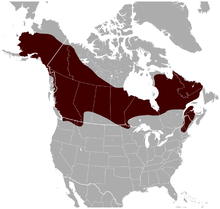Northern moor lemming
| Northern moor lemming | ||||||||||||
|---|---|---|---|---|---|---|---|---|---|---|---|---|
| Systematics | ||||||||||||
|
||||||||||||
| Scientific name | ||||||||||||
| Synaptomys borealis | ||||||||||||
| ( Richardson , 1828) |
The northern moor lemming ( Synaptomys borealis ) is a rodent in the voles subfamily .
features
| 1 | · | 0 | · | 0 | · | 3 | = 16 |
The species reaches a total length of 102 to 150 mm, including a 15 to 30 mm long tail. It has 14 to 22 mm long rear feet and 11 to 15 mm long ears that protrude clearly from the fur. The weight varies between 21.7 and 48.0 g. The coarse and fringed fur of the Northern Moor Lemming is gray-brown to chestnut brown on top, while the underside is covered by light gray fur. Furthermore, the short tail is brown on top and white on the underside. There may be a small white spot on the sides of the body of the males marking a gland . As with the southern moor lemming, there are light orange-brown areas at the base of the ears.
Females have two pairs of teats on their breasts and two pairs of teats in their groin . In the southern moor lemming, however, there are only three pairs of teats. Another characteristic of the northern species are the strongly inwardly inclined outer edges of the upper molars and the similarly inclined inner edges of the lower molars. There are no triangular cusps on the lower molars .
distribution
The distribution area of the northern moor lemmings extends over large parts of Canada and Alaska , with the exception of the northern tundra and Newfoundland . In the south, the species reaches northern areas of individual US states. As the German name suggests, it prefers bogs covered with peat moss ( Sphagnum ), sour grasses (Cyperaceae) or sweet grasses . The Northern Moor Lemming can adapt to other humid habitats . The species can be found in the mountains up to an altitude of 2300 meters.
Way of life
This moor lemming can be active at any time of the day or year. He creates trails in the grass layer or uses existing paths that other rodents have made. The nest consists of interwoven grasses and leaves. It is hidden in the flat vegetation or in underground caves that are covered with snow in winter. Underground shelters are dug themselves or taken over by other animals.
As a food grasses, Sedge, species of the genus are saxifrage ( Saxifraga ) and Potentilla ( Potentilla ) adopted. Remains of these plants could be detected in the excrement of the northern moor lemmings. Presumably it also tolerates a kind of bay rose ( Kalmia ), which is poisonous for other vertebrates. Sometimes smaller molluscs like snails are eaten.
In females there are several litters between May and the beginning of September. After a suspected pregnancy of three weeks, 2 to 9 young animals are born, usually 4 or 5. Sexual maturity occurs after 5 to 6 weeks. Females can mate again just one day after the offspring are born.
The species is an important prey animal for several birds of prey, martens and foxes.
status
The IUCN classifies the Northern Morrlemming as not threatened ( Least Concern ). Although the species is not common, it has a large range and is present in several protected areas. There are no major threats.
Individual evidence
- ↑ a b c d e f g Naughton, Donna (Ed.): The Natural History of Canadian Mammals . University of Toronto Press, 2012, ISBN 978-1-4426-4483-0 , pp. 178-179 (English, Synaptomys borealis ).
- ↑ a b c Danielle Nicholas: Northern bog lemming on the University of Michigan Museum of Zoology's Animal Diversity Web. Retrieved December 18, 2016.
- ^ A b c Northern Bog Lemming ( en ) Minnesota, Department of Natural Resources. Retrieved December 18, 2016.
- ^ A b Northern Bog Lemming ( en ) Montana Natural Heritage Program. Retrieved December 18, 2016.
- ↑ a b Synaptomys borealis in the endangered Red List species the IUCN 2008. Posted by: Linzey, AV & NatureServe (Reichel, JD & Hammerson, G.), 2008. Accessed December 18, 2016th
